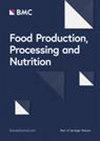Comparison of nutritional composition, bioactivities, and FTIR- ATR microstructural properties of commercially grown four mushroom species in Sri Lanka; Agaricus bisporus, Pleurotus ostreatus, Calocybe sp. (MK-white), Ganoderma lucidum
IF 5.7
3区 农林科学
Q2 FOOD SCIENCE & TECHNOLOGY
引用次数: 0
Abstract
Abstract Mushrooms have been consumed as delicacies since ancient times; however, little knowledge is available on the nutritional and bioactive properties of commercially grown mushroom species in Sri Lanka; button ( Agaricus bisporus ), oyster ( Pleurotus ostreatus ), Makandura white ( Calocybe sp.), and Reishi ( Ganoderma lucidum ). Samples from four mushroom species were analysed for proximate composition, mineral and fatty acid content, and antioxidant, antidiabetic, and microstructural properties. Carbohydrate, protein, fat, ash, and dietary fibre content in mushroom species ranged from 64.83–79.97%, 10.53–23.29%, 0.57–4.37%, 2.80–11.00%, and 33.04 to 75.33%, respectively. The highest ( P ≤ 0.05) protein and ash content were observed in A. bisporus , and G. lucidum had the highest ( P ≤ 0.05) fat and dietary fibre content. When considering the micronutrients, G. lucidum comprised higher ( P ≤ 0.05) Ca, Mg, Mn, and Cu, while A. bisporus had higher ( P ≤ 0.05) Fe and Zn contents than other species. Essential omega-6 fatty acid, linoleic (18:2n-6) content was in the range of 37- 81% in studied mushroom samples. Results obtained from FTIR (Fourier transform infrared spectroscopy) in conjunction with ATR (Attenuated total reflectance) revealed the presence of functional groups associated with fat (̴1740 cm −1 ), protein (̴1560 cm −1 ), polysaccharides (1500–750 cm −1 ) and moisture (̴3300 cm −1 ) in mushroom samples. According to the results, P. ostreatus showed the highest ( P ≤ 0.05) polysaccharide content, while G. lucidum showed the lowest ( P ≤ 0.05). The highest ( P ≤ 0.05) total phenolic content (TPC) (3.95 ± 0.05 mg GAE/g DW) and total flavonoid content (TFC) (2.17 ± 0.06 mg CE/g DW) were observed in P. ostreatus . Antioxidant activity measured by DPPH, ABTS, and FRAP methods was higher ( P ≤ 0.05) in P. ostreatus and A. bisporus compared to the other two species. Among all the studied mushroom species, G. lucidum showed the highest ( P ≤ 0.05) α -amylase (IC 50 = 77.51 ± 6.80 µg/mL) and α -glucosidase (IC 50 = 0.4113 ± 0.08 µg/mL) inhibition activities. This study reveals the potential of using A. bisporus , G. lucidum , and P. ostreatus for nutritional, functional, and therapeutic uses. Graphical Abstract斯里兰卡4种商业种植蘑菇的营养成分、生物活性和FTIR- ATR显微结构特性比较双孢蘑菇、平菇、甘露菇、灵芝
蘑菇自古以来就被当作美味佳肴食用;然而,对斯里兰卡商业种植的蘑菇品种的营养和生物活性特性知之甚少;钮子(Agaricus bisporus)、牡蛎(Pleurotus ostreatus)、白麻瓜(Calocybe sp.)和灵芝(灵芝)。研究人员分析了四种蘑菇样品的近似组成、矿物质和脂肪酸含量、抗氧化、抗糖尿病和微观结构特性。食用菌碳水化合物、蛋白质、脂肪、灰分和膳食纤维含量分别为64.83 ~ 79.97%、10.53 ~ 23.29%、0.57 ~ 4.37%、2.80 ~ 11.00%和33.04 ~ 75.33%。蛋白质和灰分含量以双孢菇最高(P≤0.05),脂肪和膳食纤维含量最高(P≤0.05)。在微量元素方面,灵芝的Ca、Mg、Mn和Cu含量(P≤0.05)高于其他品种,双孢酵母的Fe和Zn含量(P≤0.05)高于其他品种。食用菌样品中必需ω -6脂肪酸亚油酸(18:2n-6)含量在37 ~ 81%之间。FTIR(傅里叶变换红外光谱)和ATR(衰减全反射)的结果显示,蘑菇样品中存在与脂肪(- 1740 cm−1)、蛋白质(- 1560 cm−1)、多糖(- 1500-750 cm−1)和水分(- 3300 cm−1)相关的官能团。结果表明,山参多糖含量最高(P≤0.05),灵芝多糖含量最低(P≤0.05)。总酚含量(TPC)(3.95±0.05 mg GAE/g DW)和总黄酮含量(TFC)(2.17±0.06 mg CE/g DW)最高(P≤0.05)。DPPH、ABTS和FRAP法测定的抗氧化活性均高于其他两种(P≤0.05)。其中,灵芝对α -淀粉酶(IC 50 = 77.51±6.80µg/mL)和α -葡萄糖苷酶(IC 50 = 0.4113±0.08µg/mL)的抑制活性最高(P≤0.05)。这项研究揭示了双孢菇、灵芝菇和青霉在营养、功能和治疗方面的潜力。图形抽象
本文章由计算机程序翻译,如有差异,请以英文原文为准。
求助全文
约1分钟内获得全文
求助全文
来源期刊

Food Production, Processing and Nutrition
Medicine-Public Health, Environmental and Occupational Health
CiteScore
6.90
自引率
4.30%
发文量
28
审稿时长
12 weeks
 求助内容:
求助内容: 应助结果提醒方式:
应助结果提醒方式:


